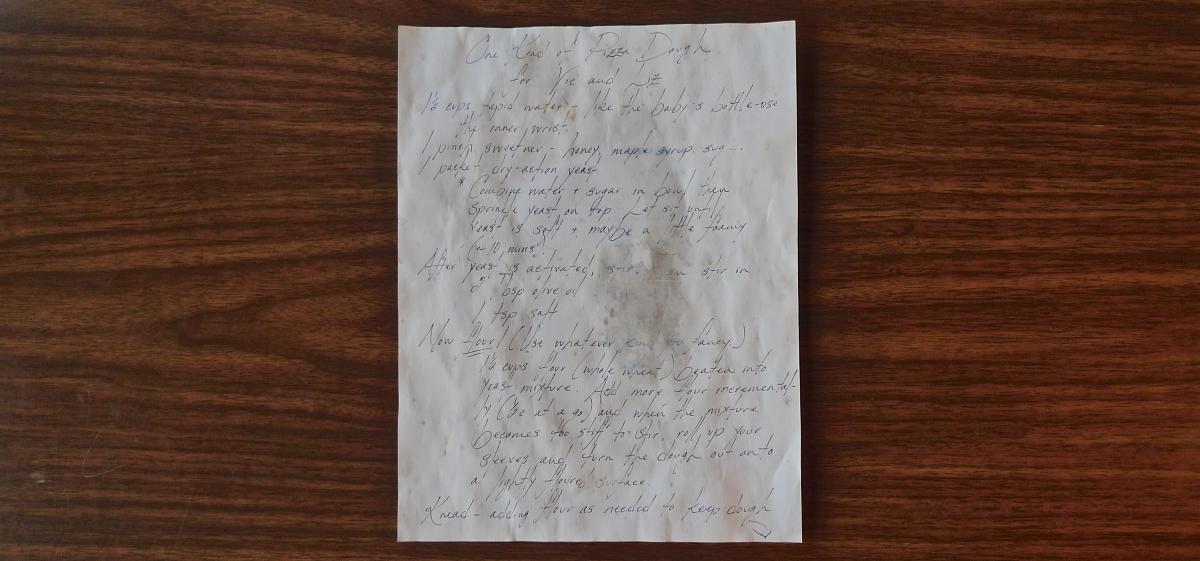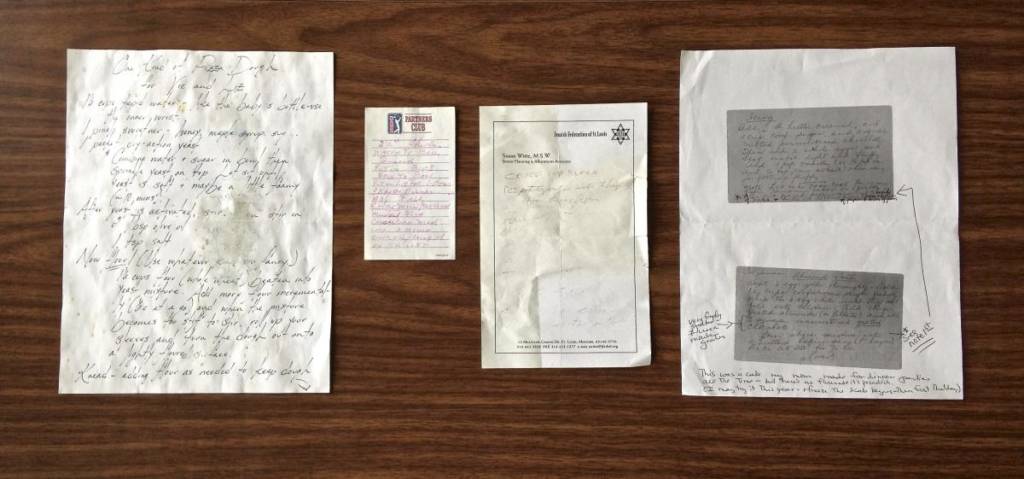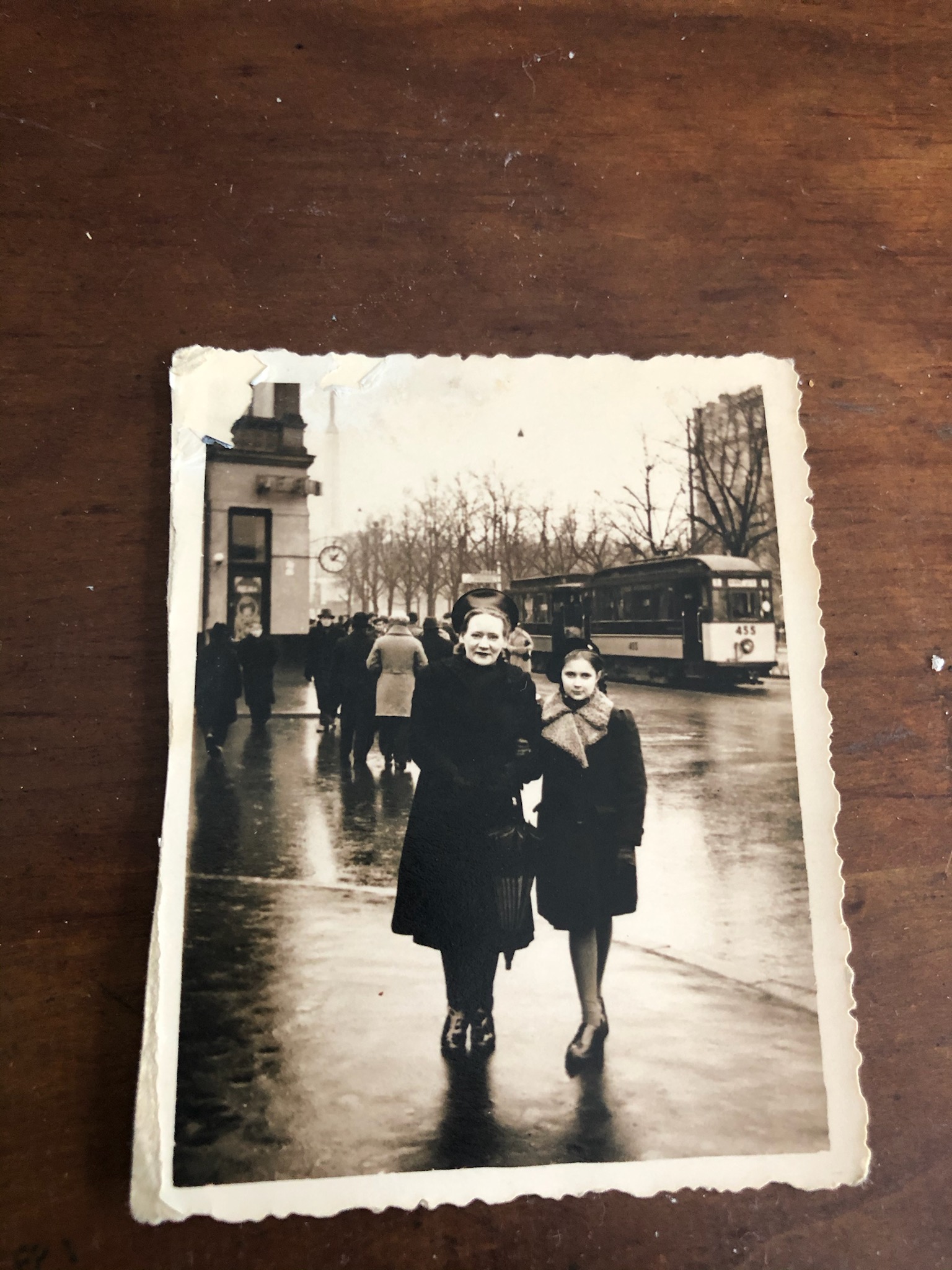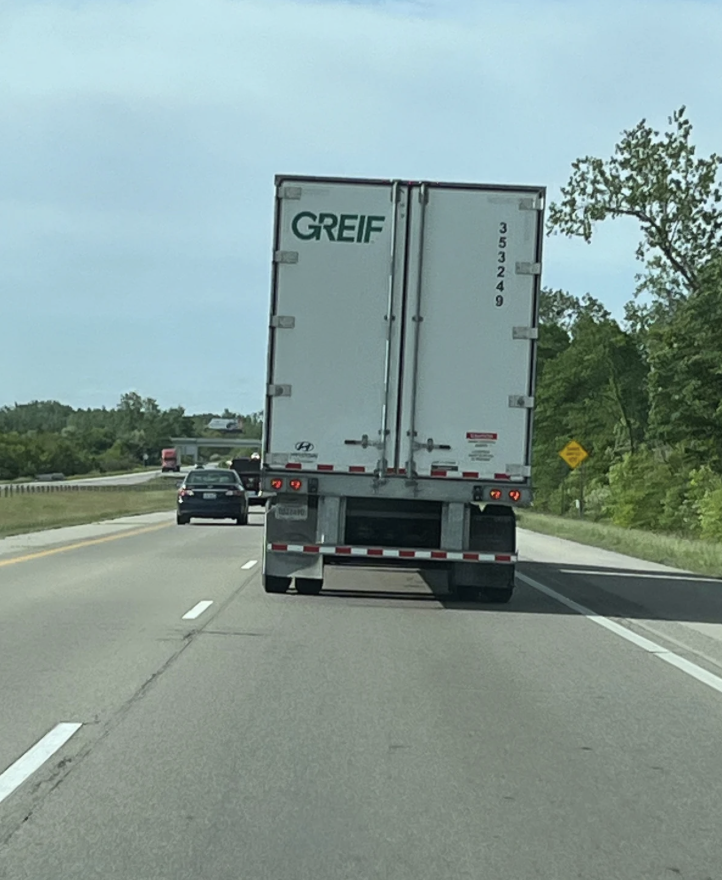CRISCO IN A BLOCK
I’m not really sure why it’s all so illegible now. The ink fades to nothing midway through and is gasping for breath where it’s visible at all. I have a vague recollection of the page living on one side of the fridge for a time (reminding us of its existence)—so perhaps the sunlight hit it just so. Or perhaps the pen itself was too weak, not up to the task.
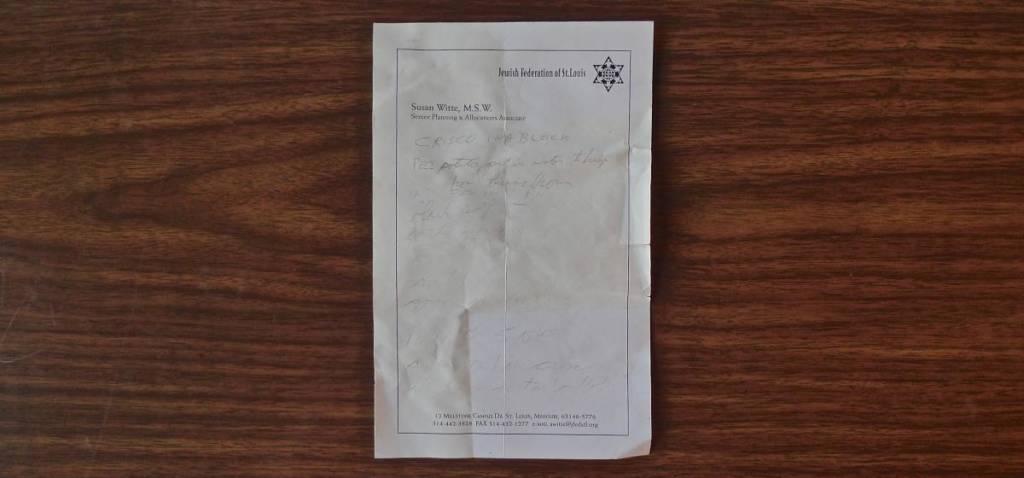
Vic wrote down this now nearly obliterated recipe on my mother’s notepad while we were visiting my parents sometime in the last five to ten years. I recognize his handwriting, the mix of upper and lower case, and recall a trip home during which such an event may have occurred. I know this is about homemade French fries, though all that’s really legible is the note regarding the Crisco followed by “PEEL potato, put in water to keep from turning brown. black pepper…10 MIN/SIDE.” The Crisco part is important—“in a block”—necessary for proper execution.
These were, unsurprisingly, a favorite in my house growing up—potatoes, fried, at home, in relatively large quantities—my brother and I loved them. That Vic wrote down the recipe means my dad was making them for us on this visit, that we were being instructed, that we had the idea to replicate the experience in our home. I’m nearly positive we’ve never made them ourselves. The page is a marker of that moment, of endurance, and the lack thereof, in one method of cooking potatoes. Maybe we tried it once.
The box is a cardboard file—hinged top flipped up, drop front hanging down—holding a mass of papers: handwritten notes, photocopied cards and pages from books, tired pages torn from magazines, pages printed out years ago from various websites, .txt documents, emails. It lacks any attempt at organization, aside from the rare binder clip or makeshift fastener holding together sheets with some common denominator: ingredient, origin, era.
One Kind of Pizza Dough for Vic and Liz
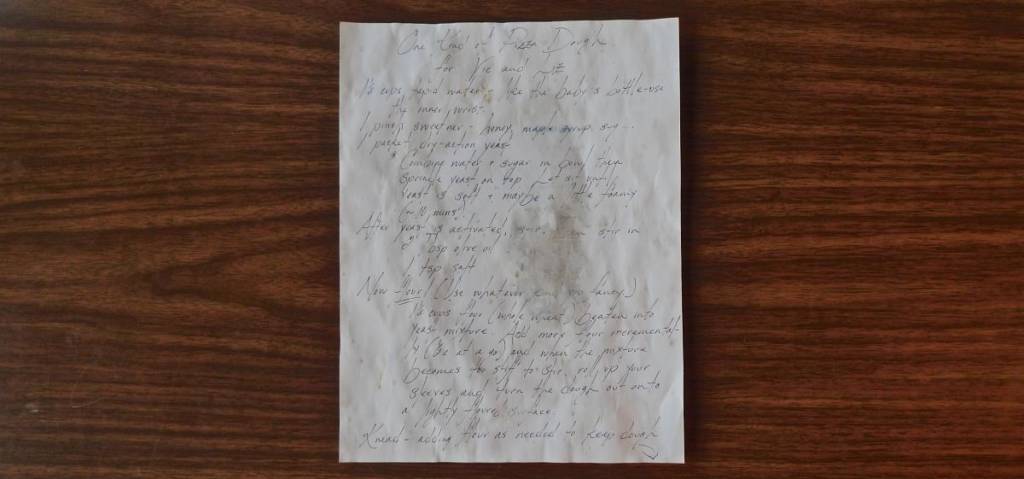
I resort quite frequently to the ease of electronic files that can be typed once, saved in some ambiguous place, and printed on demand (or better yet, emailed)—“I’ll need this again anyway” reasoning at work. But in the handwritten document, better yet the recipe or instruction, there is a sense of the body of origin. A guiding voice made audible on paper through the hand, but also the existence of it elsewhere—the voice made audible by muscle and air, the connecting mechanisms—physical and otherwise—between writer and reader.
The page is now stained with flour and oil (translucent in places) and a drip of something brown which may be syrup (“1 pinch sweetener – honey, maple syrup, sug…”), heavy with use, one side bleeding into the other, worn from months affixed to the other side of the refrigerator. I’m pretty sure I always knead the dough too long, leading to something a bit breadier than I intend. I’ve tried other recipes, turned to the online glut of food-focused ideologues. But, in spite of my uneven execution, I return to this—instruction as correspondence, the markings of a friend undeniably present.
The box itself is the common denominator. It provides the enclosure, is what these notes have in common: that they are there, here, because they are mine, ours. Each page marks a point in time where I or someone said, you should make this. Or perhaps more precisely, here, go, make.
2 ½ # Chicken
That’s a pound sign, being used to denote weight, as in libra pondo, pound by weight. A 2 ½ pound chicken. That this is written on a small page from a “PGA Tour Partners Club” notepad leads me to believe, and vaguely recall, that this was written by my grandpa Albert—avid golfer, in spite of the stroke that left him mostly paralyzed on one side of his body at a relatively young age.
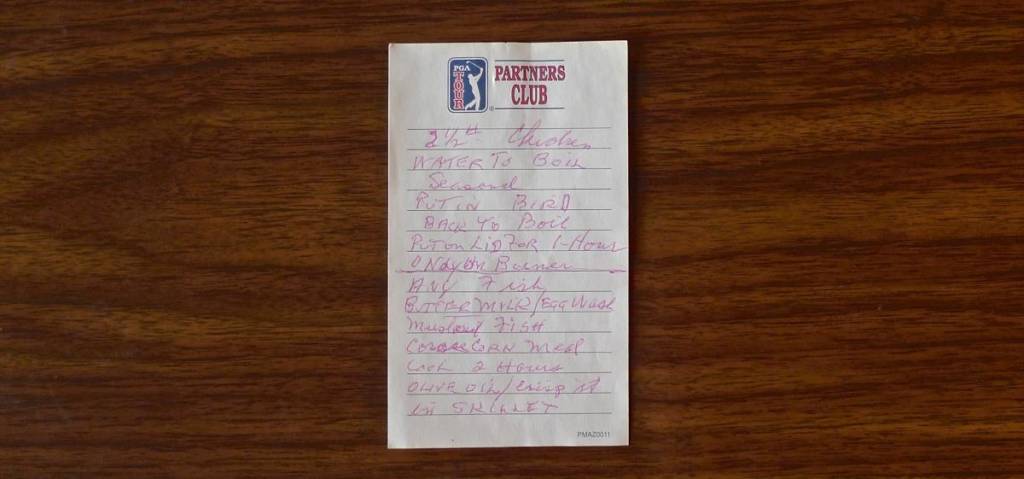
This was recorded sometime on my last (Vic’s first) visit to my grandparents’ condo in Delray Beach, Florida. It was a visit marked by more than a few disturbing statements (religion, politics, immigration, etc.) and a usual amount of marital bickering. This was a few months before they would move up to St. Louis to be closer to my parents, as my grandma Sarah’s health continued its decline.
Albert was a singular man known for, among other things, his verbosity and enduring willingness to tell you his way of doing something—anything, or whatever else was on his mind at the moment. This seems to be the starkest of instructions for making chicken stock (or poaching a chicken?). What it lacks in length it makes up for with its cryptic density.
“WATER TO BOIL
Seasoned
PUT IN BIRD
BACK TO BOIL
Put on lid for 1-hour
ONLY on burner.”
This, followed by an extremely brief and equally vague guide to cooking “ANY Fish.”
There are others like this. Ambiguous diagrams, dashed off lists of ingredients and actions to take or avoid. Markers of times and places and people who are or are not here, now. Tokens of what was once desired or mused over or merely seasonal. Flipping through each page is a quick glancing through memory—some parts clearer than others.
For Susan: Almond Torte
Susan is my mother. This 8 ½ x 11” sheet of paper consists of her handwritten annotations to the photocopied front and back of a recipe card that my grandmother, Mollie, wrote out for her. Two sets of handwriting that graced decades of birthday cards and notes, to each other and to me. In total this page is a recording of two generations speaking to a third.
This was a cake my mom made for dinner parties all the time – but there’s no flour so it’s Pesadich. (I may try it this year – & freeze the 2 cake layers. Then frost that day.)
The above note appears at the bottom of the page. Just above that is the main recipe for the cake beginning, “Beat 6 egg yolks thoroughly.” There is no list of ingredients set apart. All quantities are fully integrated into the whole. The page is part map part narrative diagram.
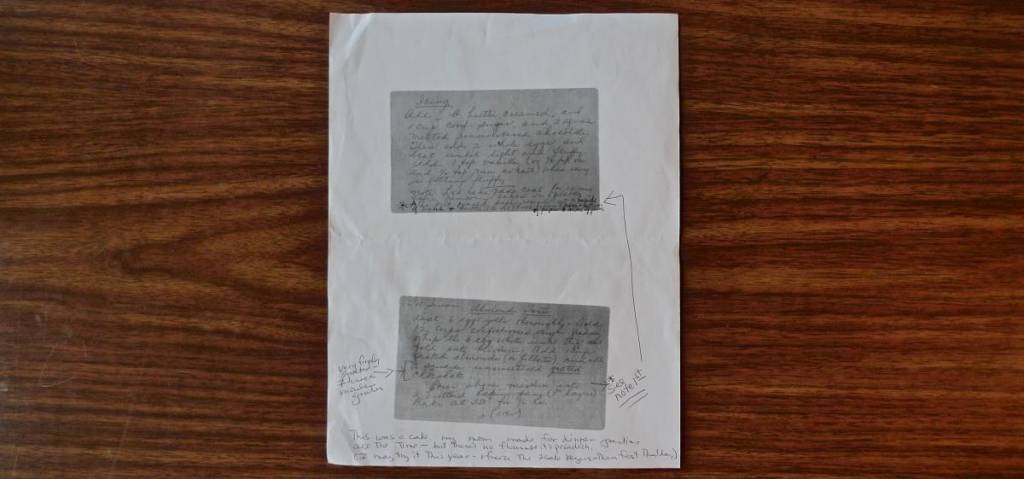
At the top is an image of the back of the card, listing the icing recipe followed by two notes: the first essentially, let the cake pans cool slightly before removing each cake to a plate; the second, an aside indicating that one should have first lined the pans with buttered (or oiled) waxed paper before pouring the batter in and baking it in the first place. A series of arrows and a note from my mom call my attention here, indicate this key step at the point of greatest utility (“pour above mixture into 2 buttered baking pans”) in the image of the front of the card below. *See note 1st, she says.
I periodically glance at the box and consider organizing its contents. There’s a divided accordion file standing empty behind it, waiting. But to categorize each piece seems artificial and inadequate. Something in the unruliness of the mess maintains the sprawling reach of each page, preserves the weight or character of the whole. It is continually shifting—or rather, being added to. Rarely have I cleaned house.
Elizabeth Witte received her MFA in poetry from the Bennington Writing Seminars and is the Associate Editor of The Common. She is the author of the chapbook Dry Eye (Dancing Girl Press, 2014).
Photos by Vic Rawlings.
